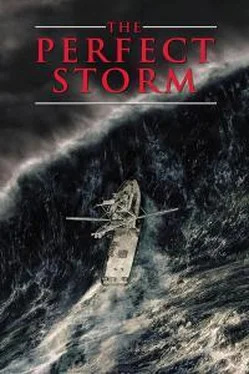Sebastian Junger - The Perfect Storm
Здесь есть возможность читать онлайн «Sebastian Junger - The Perfect Storm» — ознакомительный отрывок электронной книги совершенно бесплатно, а после прочтения отрывка купить полную версию. В некоторых случаях можно слушать аудио, скачать через торрент в формате fb2 и присутствует краткое содержание. Жанр: Триллер, Проза. Описание произведения, (предисловие) а так же отзывы посетителей доступны на портале библиотеки ЛибКат.
- Название:The Perfect Storm
- Автор:
- Жанр:
- Год:неизвестен
- ISBN:нет данных
- Рейтинг книги:3 / 5. Голосов: 1
-
Избранное:Добавить в избранное
- Отзывы:
-
Ваша оценка:
- 60
- 1
- 2
- 3
- 4
- 5
The Perfect Storm: краткое содержание, описание и аннотация
Предлагаем к чтению аннотацию, описание, краткое содержание или предисловие (зависит от того, что написал сам автор книги «The Perfect Storm»). Если вы не нашли необходимую информацию о книге — напишите в комментариях, мы постараемся отыскать её.
The Perfect Storm — читать онлайн ознакомительный отрывок
Ниже представлен текст книги, разбитый по страницам. Система сохранения места последней прочитанной страницы, позволяет с удобством читать онлайн бесплатно книгу «The Perfect Storm», без необходимости каждый раз заново искать на чём Вы остановились. Поставьте закладку, и сможете в любой момент перейти на страницу, на которой закончили чтение.
Интервал:
Закладка:
JOHNSTON had finished his last haul late in the afternoon of the 28th: nineteen swordfish, twenty bigeye, twenty-two yellowfin, and two mako. He immediately started steaming north and by morning he was approaching the Tail of the Banks, winds out of the northeast at one hundred knots and seas twenty to thirty feet. Several hundred miles to the west, though, conditions have gone off the chart. The Beaufort Wind Scale defines a Force 12 storm as having seventy-three-mile-an-hour winds and forty-five-foot seas. Due south of Sable Island, data buoy #44137 starts notching seventy-five-foot waves on the afternoon of the 29th and stays up there for the next seventeen hours. Significant wave height—the average of the top third, also known as HSig—tops fifty feet. The first hundred-foot wave spikes the graph at eight PM, and the second one spikes it at midnight. For the next two hours, peak wave heights stay at a hundred feet and winds hit eighty miles an hour. The waves are blocking the data buoy readings, though, and the wind is probably hitting 120 or so. Eighty-mile-an-hour wind can suck fish right out of bait barrels. Hundred-foot waves are fifty percent higher than the most extreme sizes predicted by computer models. They are the largest waves ever recorded on the Scotian Shelf. They are among the very highest waves measured anywhere in the world, ever.
Scientists understand how waves work, but not exactly how huge ones work. There are rogue waves out there, in other words, that seem to exceed the forces generating them. For all practical purposes, though, heights of waves are a function of how hard the wind blows, how long it blows for, and how much sea room there is—"speed, duration, and fetch,” as it's known. Force 12 winds over Lake Michigan would generate wave heights of thirty-five feet after ten hours or so, but the waves couldn't get any bigger than that because the fetch—the amount of open water—isn't great enough. The waves have reached what is called a "fully developed sea state." Every wind speed has a minimum fetch and duration to reach a fully developed sea state; waves driven by a Force 12 wind reach their full potential in three or four days. A gale blowing across a thousand miles of ocean for sixty hours would generate significant wave heights of ninety-seven feet; peak wave heights would be more than twice that. Waves that size have never been recorded, but they must be out there. It's possible that they would destroy anything in a position to measure them.
All waves, no matter how huge, start as rough spots—cats' paws—on the surface of the water. The cats' paws are filled with diamond-shaped ripples, called capillary waves, that are weaker than the surface tension of water and die out as soon as the wind stops. They give the wind some purchase on an otherwise glassy sea, and at winds over six knots, actual waves start to build. The harder the wind blows, the bigger the waves get and the more wind they are able to "catch." It's a feedback loop that has wave height rising exponentially with wind speed.
Such waves are augmented by the wind but not dependent on it; were the wind to stop, the waves would continue to propagate by endlessly falling into the trough that precedes them. Such waves are called gravity waves, or swells; in cross-section they are symmetrical sine curves that undulate along the surface with almost no energy loss. A cork floating on the surface moves up and down but not laterally when a swell passes beneath it. The higher the swells, the farther apart the crests and the faster they move. Antarctic storms have generated swells that are half a mile or more between crests and travel thirty or forty miles an hour; they hit the Hawaiian islands as breakers forty feet high.
Unfortunately for mariners, the total amount of wave energy in a storm doesn't rise linearly with wind speed, but to its fourth power. The seas generated by a forty-knot wind aren't twice as violent as those from a twenty-knot wind, they're seventeen times as violent. A ship's crew watching the anemometer climb even ten knots could well be watching their death sentence. Moreover, high winds tend to shorten the distance between wave crests and steepen their faces. The waves are no longer symmetrical sine curves, they're sharp peaks that rise farther above sea level than the troughs fall below it. If the height of the wave is more than one-seventh the distance between the crests—the "wavelength"—the waves become too steep to support themselves and start to break. In shallow water, waves break because the underwater turbulence drags on the bottom and slows the waves down, shortening the wavelength and changing the ratio of height to length. In open ocean the opposite happens: wind builds the waves up so fast that the distance between crests can't keep up, and they collapse under their own mass. Now, instead of propagating with near-zero energy loss, the breaking wave is suddenly transporting a huge amount of water. It's cashing in its chips, as it were, and converting all its potential and kinetic energy into water displacement.
A general rule of fluid dynamics holds that an object in the water tends to do whatever the water it replaces would have done. In the case of a boat in a breaking wave, the boat will effectively become part of the curl. It will either be flipped end over end or shoved backward and broken on. Instantaneous pressures of up to six tons per square foot have been measured in breaking waves. Breaking waves have lifted a 2,700-ton breakwater, en masse, and deposited it inside the harbor at Wick, Scotland. They have blasted open a steel door 195 feet above sea level at Unst Light in the Shetland Islands. They have heaved a half-ton boulder ninety-one feet into the air at Tillamook Rock, Oregon.
There is some evidence that average wave heights are slowly rising, and that freak waves of eighty or ninety feet are becoming more common. Wave heights off the coast of England have risen an average of 25 percent over the past couple of decades, which converts to a twenty-foot increase in the highest waves over the next half-century. One cause may be the tightening of environmental laws, which has reduced the amount of oil flushed into the oceans by oil tankers. Oil spreads across water in a film several molecules thick and inhibits the generation of capillary waves, which in turn prevent the wind from getting a "grip" on the sea. Plankton releases a chemical that has the same effect, and plankton levels in the North Atlantic have dropped dramatically. Another explanation is that the recent warming trend—some call it the greenhouse effect—has made storms more frequent and severe. Waves have destroyed docks and buildings in Newfoundland, for example, that haven't been damaged for decades.
As a result, stresses on ships have been rising. The standard practice is to build ships to withstand what is called a twenty-five-year stress—the most violent condition the ship is likely to experience in twenty-five years. The wave that flooded the wheelhouse of the Queen Mary, ninety feet up, must have nearly exceeded her twenty-five-year stress.
North Sea oil platforms are built to accommodate a 111 -foot wave beneath their decks, which is calculated to be a one-hundred-year stress. Unfortunately, the twenty-five-year stress is just a statistical concept that offers no guarantee about what will happen next year, or next week. A ship could encounter several twenty-five-year waves in a month or never encounter any at all. Naval architects simply decide what level of stress she's likely to encounter in her lifetime and then hope for the best. It's economically and structurally impractical to construct every boat to hundred-year specifications.
Inevitably, then, ships encounter waves that exceed their stress rating. In the dry terminology of naval architecture, these are called "nonnegotiable waves." Mariners call them "rogue waves" or "freak seas." Typically they are very steep and have an equally steep trough in front of them—a "hole in the ocean" as some witnesses have described it. Ships cannot get their bows up fast enough, and the ensuing wave breaks their back. Maritime history is full of encounters with such waves. When Sir Ernest Shackleton was forced to cross the South Polar Sea in a twenty-two-foot open life boat, he saw a wave so big that he mistook its foaming crest for a moonlit cloud. He only had time to yell, "Hang on, boys, it's got us!" before the wave broke over his boat. Miraculously, they didn't sink.
Читать дальшеИнтервал:
Закладка:
Похожие книги на «The Perfect Storm»
Представляем Вашему вниманию похожие книги на «The Perfect Storm» списком для выбора. Мы отобрали схожую по названию и смыслу литературу в надежде предоставить читателям больше вариантов отыскать новые, интересные, ещё непрочитанные произведения.
Обсуждение, отзывы о книге «The Perfect Storm» и просто собственные мнения читателей. Оставьте ваши комментарии, напишите, что Вы думаете о произведении, его смысле или главных героях. Укажите что конкретно понравилось, а что нет, и почему Вы так считаете.












